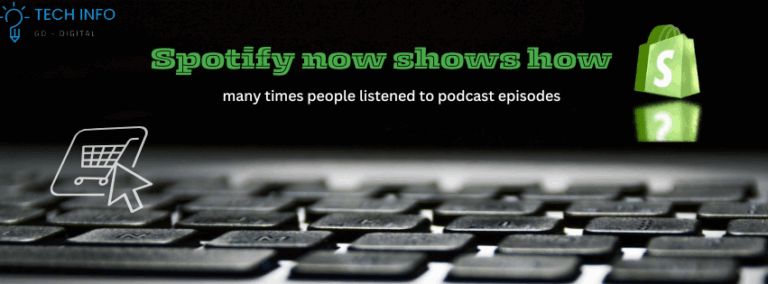Table of Contents
ToggleSpotify Now Displays Podcast Episode Plays: What It Means for Creators and Listeners
In a move that’s generating buzz across the podcasting world, Spotify has officially started showing the number of times people have listened to individual podcast episodes. This update brings a new layer of transparency to the platform and signals a significant shift in how podcast performance is measured and perceived. Whether you’re a casual listener, a podcast superfan, or a creator trying to grow your audience, this feature could change how you experience and evaluate content on Spotify.
In this blog post, we’ll explore what this change means, why it matters, and how it could shape the future of podcasting
Why Is This a Big Deal?
Until now, Spotify has withheld granular play counts for most podcasts, only providing general analytics to creators through Spotify for Podcasters. Listeners had no way of knowing how popular a specific episode was — only the podcast’s overall popularity was vaguely inferred through follower counts and star ratings. By adding visible episode-level play counts, Spotify is introducing a feature long standard on platforms like YouTube and TikTok.
For creators, this is a welcome evolution. It offers social proof that can validate the quality of a specific episode or series. For listeners, it provides a way to quickly identify the most popular or impactful episodes within a podcast, especially when exploring new shows.
Key Benefits for Podcast Creators
1. Improved Discoverability
Popular episodes will now likely attract even more attention. When users can see that an episode has 1 million listens, they’re more inclined to click and give it a try. This natural visibility boost is great for older episodes that may still offer timeless value.
2. Data-Driven Growth
While creators already had access to back-end analytics, seeing the numbers publicly helps them benchmark against others in their niche. It can inspire content strategy pivots based on what resonates most with wider audiences.
3. Attracting Sponsors and Collaborations
A visible episode play count becomes a public metric that creators can use to negotiate sponsorship deals and collaborative opportunities. It’s no longer just about total downloads — episode-level impact now plays a bigger role in monetization.
4. Social Credibility
In the world of content, popularity often signals quality. Creators who consistently produce high-play episodes can leverage that social proof to build authority in their niche.
What It Means for Listeners
1. Easier Episode Selection
If you’re diving into a podcast with 200 episodes, the play counts can guide you toward the most engaging or viral content. It takes the guesswork out of finding the “best” episodes.
2. Community Insight
Seeing what others listen to creates a subtle sense of community. If thousands of people enjoyed a particular episode, there’s a good chance you might too.
3. Better Recommendations
It’s possible that Spotify will eventually integrate play count data into its algorithmic recommendations, which means the platform could serve up more widely liked content tailored to your preferences.
How Spotify Displays Episode Plays
Currently, Spotify displays the number of plays beneath the episode title in a smaller font, typically listed as “10K plays,” “100K plays,” or “1M plays.” These numbers represent unique plays — meaning Spotify counts one play per listener device, not total streams from the same user. This avoids inflated stats and provides a more accurate reflection of episode popularity.
It’s worth noting that this feature is gradually rolling out, so you may not see play counts on all episodes or regions immediately. Spotify has confirmed that the metric will apply to episodes released after a certain date, and older episodes may not show historical plays if they predate this system.
The Impact on the Podcast Industry
Spotify’s decision isn’t just a UI update — it’s a potential industry disruptor. With podcasting becoming an increasingly competitive space, play counts could affect everything from chart rankings to advertising rates and even platform loyalty.
Other platforms like Apple Podcasts and Google Podcasts may feel pressured to offer similar transparency, especially if creators begin favoring Spotify for its openness. In essence, Spotify is treating podcasting more like video content, adopting lessons from platforms like YouTube where performance transparency is the norm.
Concerns and Criticisms
While the update has mostly received positive feedback, there are a few concerns:
1. Pressure on Smaller Creators
Some podcasters worry that visible low play counts could turn away potential listeners. Much like new YouTubers who struggle to gain views early on, emerging podcasters may feel disheartened.
2. Favoring Popularity Over Quality
With visible metrics, listeners may gravitate only toward the most popular content, potentially overlooking niche or underrated gems. This may unintentionally shift focus from diverse voices to mainstream-heavy hits.
3. Data Misinterpretation
Casual users might not understand what “10K plays” really represents — is that good or bad for a niche show? Without context, play counts could be misleading.
Spotify will need to address these issues either through education or through complementary features like category-specific charts and curated recommendations.
Final Thoughts
Spotify’s move to display podcast episode play counts is more than a cosmetic change — it reflects a broader shift toward transparency, community influence, and data-driven content discovery. As podcasts continue to explode in popularity, this update equips both listeners and creators with tools to make smarter decisions.
While it might create short-term pressure for new creators, the long-term effect will likely be positive. Better data means better content, and better content means more engaged audiences.
As the lines blur between podcasting and other forms of digital media, expect more features like this to roll out across platforms. Spotify is betting big on the future of podcasts — and with this move, it’s inviting the rest of the world to watch (and measure) along.





